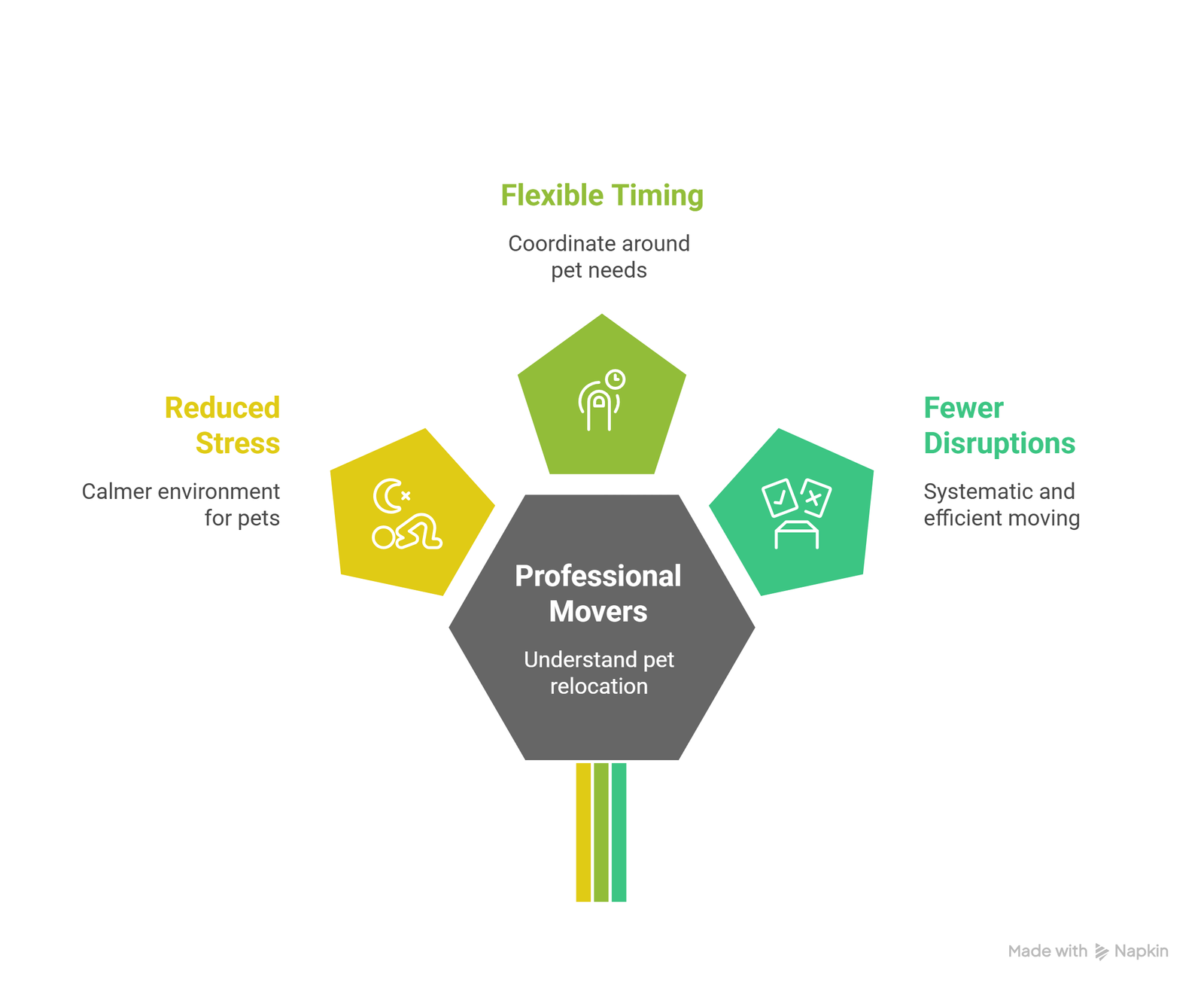Moving with Pets in Clarington: Stress-Free Tips for a Smooth Transition
Moving to a new home is exciting, but if you’re a pet owner in Clarington, you know that your furry, feathered, or scaly family members experience the change differently than you do. While you’re focused on packing boxes and coordinating logistics, your pets can sense the disruption to their routine and may become anxious, confused, or stressed. Whether you’re relocating from Bowmanville to Courtice, moving across Newcastle, or settling into a new neighbourhood in Orono, making the transition smooth for your pets requires thoughtful planning and patience.
The good news is that moving with pets in Clarington doesn’t have to be overwhelming. With the right preparation and a few strategic pet moving tips, you can help your beloved companions adjust to the change with minimal stress. Pets thrive on routine and familiarity, so maintaining as much normalcy as possible throughout the moving process is essential. From pre-move preparation to settling into your new space, every step you take can make a significant difference in your pet’s comfort level.
This comprehensive pet-friendly moving guide will walk you through everything you need to know about stress-free pet relocation. We’ll cover how to prepare your pets before moving day, keep them safe and calm during the actual move, and help them adjust to their new environment. By the end, you’ll have a clear action plan that ensures both you and your four-legged friends enjoy a positive moving experience.
Understanding How Pets React to Moving
Before diving into specific strategies, it’s important to understand why moving affects pets so deeply. Animals are creatures of habit who find comfort in familiar smells, sounds, and surroundings. When their environment suddenly changes, they can experience genuine stress and anxiety. Dogs might become clingy or act out with unusual behaviour. Cats often hide or refuse to eat. Even small pets like birds, rabbits, or hamsters can become agitated when their routine is disrupted.
Your pet doesn’t understand that you’re moving to a better home or closer to work. They only know that something feels wrong—their bed is gone, strange people are carrying furniture out the door, and the comforting scents they rely on are disappearing. This confusion can manifest as stress-related behaviours including excessive barking, inappropriate elimination, destructive chewing, or withdrawal.
Recognizing these signs helps you respond with compassion rather than frustration. Your calm, reassuring presence makes an enormous difference. When you remain patient and maintain a positive attitude, your pets pick up on that energy and feel more secure despite the chaos around them.
Preparing Your Pets Before Moving Day
Preparation is the cornerstone of stress-free pet relocation. Start getting your pets ready at least two to three weeks before your move. Gradual changes are far less stressful than sudden disruptions, so introduce new routines slowly while maintaining their regular feeding times, walks, and play sessions as much as possible.
Visit your veterinarian for a pre-move checkup. This ensures your pet is healthy enough for the transition and gives you an opportunity to request copies of medical records, update vaccinations, and refill any necessary medications. If you’re moving to a different area within the Durham Region, ask your vet for recommendations in your new neighbourhood or research veterinary clinics near your new home ahead of time.
Update your pet’s identification tags with your new address and phone number. If your pet isn’t already microchipped, seriously consider having this done before the move. Microchipping provides permanent identification that can’t fall off like a collar tag. In the stressful environment of moving day, even the most well-behaved pets might bolt through an open door, making proper identification critical.
Get your pet accustomed to their travel carrier or crate well before moving day. Leave it out in a common area with the door open, place treats and favourite toys inside, and let them explore at their own pace. This transforms the carrier from a scary prison into a familiar, safe space where they can retreat during the chaos of moving.
Creating a Safe Space on Moving Day
Moving day itself presents the biggest challenge for pet safety and comfort. With doors constantly opening, strangers moving through your home, and general chaos, it’s easy for pets to become overwhelmed or even escape. The best strategy is creating a designated safe room where your pets can stay throughout the day.
Choose a quiet room away from the main moving activity—ideally a bathroom or spare bedroom that movers won’t need to access. Set up this space with your pet’s bed, favourite toys, water bowl, and litter box if applicable. Put a clear sign on the door warning movers not to enter. This protected environment allows your pet to feel secure while professional movers in Clarington handle the heavy work.
For dogs, you might consider doggy daycare on moving day as an alternative. Many pets are happier spending the day playing with other dogs in a familiar environment rather than being confined to one room. Similarly, boarding your cat overnight before and after the move can reduce their stress if you have a trusted facility they’ve stayed at before.
If keeping pets at home, check on them regularly throughout the day. Bring familiar treats, spend a few minutes offering reassurance, and ensure they have everything they need. Your periodic visits remind them they’re not forgotten and that you’re still there despite all the strange activity.
Transporting Pets Safely
When it’s time to transport your pets to the new home, safety is paramount. Never allow pets to roam freely in the vehicle during the move. Even the calmest animals can become frightened by unfamiliar sounds or sudden stops, potentially causing accidents or escaping when doors open.
Dogs should be secured with a pet seatbelt or travel in a properly fastened crate. Cats, small dogs, rabbits, and other small animals should always travel in secure carriers with adequate ventilation. Line the carrier bottom with absorbent padding in case of accidents, and bring extras for longer journeys. Never place carriers in the truck bed or cargo area without climate control.
For local moves within Clarington, Bowmanville, Courtice, Newcastle, or Orono, the journey is typically short enough that pets won’t need food during transport. However, always provide access to water, especially on warm days. Avoid feeding right before travel to reduce the chance of car sickness. Take breaks on longer journeys to allow bathroom opportunities for dogs, though cats and small pets are usually fine waiting until you arrive.
Keep the vehicle temperature comfortable—not too hot or cold. Never leave pets unattended in vehicles, even briefly. On moving day, you or a trusted family member should be responsible for pet transport rather than leaving this task to movers or unfamiliar helpers.
Settling Into Your New Home
Once you arrive at your new home, resist the urge to immediately let your pets explore. First, ensure the space is safe by checking for escape routes, toxic plants, exposed wires, or small items they might swallow. Set up a quiet room similar to what you created on moving day with their familiar belongings before introducing them to this space.
Let your pets acclimate gradually. Start with one room where they can safely explore, then slowly open access to other areas over the following days. This prevents overwhelming them with too much new information at once. Cats especially benefit from this gradual introduction approach, as they’re territorial creatures who need time to feel secure in new spaces.
Maintain your pet’s regular routine as much as possible from day one. Feed them at their usual times, take dogs for walks on their normal schedule, and keep playtime consistent. This familiarity provides comfort and stability amidst all the changes. Even if you’re exhausted from moving, prioritizing your pet’s routine helps them adjust faster.
Spend extra quality time with your pets during the first few weeks. They need reassurance that despite the environmental changes, your relationship remains constant. Extra cuddles, longer play sessions, and positive attention help them understand they’re safe and loved in this new place.
Pet-Specific Moving Tips
Different types of pets require different approaches to moving. Understanding your specific pet’s needs ensures you provide the most appropriate care during this transition.
Moving with Dogs
Dogs are generally the most adaptable pets when moving, but they still need support. Take your dog to explore the new neighbourhood on multiple walks before moving day if possible. Let them sniff around, meet neighbours, and become familiar with local sights and sounds. After moving, establish a new walking route quickly so they understand their new territory.
Dog-proof your new yard before giving them outdoor access. Check fencing for gaps, ensure gates latch securely, and remove any toxic plants. Even well-trained dogs might attempt to return to their old home if they escape, so exercise extra caution during the adjustment period.
Moving with Cats
Cats often struggle more with moves than dogs because they’re deeply territorial. Keep cats indoors for at least two weeks after moving, even if they were previously outdoor cats. This prevents them from trying to return to your old home and gives them time to recognize the new house as their territory.
Use synthetic feline pheromone diffusers in your new home to help cats feel more secure. These products mimic the natural calming pheromones cats produce and can significantly reduce anxiety. Place familiar scratching posts in prominent locations so cats can mark their new territory.
Moving with Small Pets
Small animals like rabbits, guinea pigs, hamsters, or birds need special considerations. Keep their cages covered during transport to reduce stress from visual stimulation. Maintain consistent temperatures as small pets are sensitive to heat and cold. Set up their habitats immediately upon arrival so they can retreat to familiar spaces.
For fish, moving requires careful planning. Small tanks can be transported with fish inside using battery-powered aerators, but larger aquariums must be partially drained. Bag fish individually in water from their tank, secure bags in insulated containers, and limit transport time. Consider asking an experienced aquarist for help if you have large or expensive fish.

How Local Movers Can Help With Pet-Inclusive Moves
Professional movers who understand pets can make your relocation significantly easier. At Clarington Movers, we’ve helped countless families move with their beloved pets and understand the unique challenges involved. Our team works efficiently to minimize the time your home is in chaos, reducing stress for both you and your animals.
We coordinate timing to fit your pet’s needs. If you need extra time to get pets settled before movers arrive, or want to transport them to your new home before furniture arrives, we work flexibly around your schedule. Our local moving services in Clarington are designed to accommodate families, including their four-legged members.
Our professional approach means fewer disruptions. We work systematically and efficiently, keeping noise levels reasonable and doors controlled. We respect your designated pet-free zones and follow any specific instructions you provide regarding your animals. This consideration creates a calmer environment for everyone involved.
Moving Services Tailored to Your Needs
Whether you’re moving a small apartment or a large family home, we offer services that work for pet owners. Our house moving services in Courtice and throughout the region include careful handling of your belongings while being mindful of your pets’ presence and comfort.
For families relocating to new neighbourhoods, our expertise in local moving in Bowmanville, Newcastle, Orono, and Oshawa means we understand the unique characteristics of each community. We can even provide insights about pet-friendly parks, trails, and amenities in your new area.
Essential Moving with Pets Checklist
To help you stay organized, here’s a comprehensive checklist covering everything you need for a successful pet-inclusive move:
| Timeline | Tasks to Complete |
| 3-4 Weeks Before | • Visit veterinarian for checkup<br>• Request medical records<br>• Update vaccinations if needed<br>• Research vets near new home<br>• Update ID tags<br>• Purchase/prepare travel carrier |
| 1-2 Weeks Before | • Maintain normal routines<br>• Pack pet supplies last<br>• Arrange pet care for moving day<br>• Pet-proof new home if accessible<br>• Notify microchip company of address change |
| Moving Day | • Keep pets in safe room or daycare<br>• Pack overnight pet bag with essentials<br>• Transport pets personally<br>• Don’t feed before travel<br>• Bring water for journey |
| First Week After | • Set up safe room immediately<br>• Maintain regular feeding/walking schedule<br>• Gradually introduce new spaces<br>• Keep cats indoors<br>• Spend extra quality time together<br>• Update pet registration with municipality |
Common Challenges and Solutions
Even with excellent planning, challenges can arise when moving with pets. Here’s how to handle common issues:
Loss of Appetite: Many pets won’t eat much during the first few days after moving. This is normal stress-related behaviour. Offer their favourite treats, maintain regular meal times, and ensure fresh water is always available. If appetite doesn’t return within three days, consult your vet.
Excessive Hiding: Cats especially may hide extensively in a new home. Create multiple safe hiding spots, don’t force interaction, and give them time. Place food, water, and litter boxes in accessible locations near their hiding places. Most cats gradually emerge as they become comfortable.
Destructive Behaviour: Some dogs or cats express moving stress through destructive chewing or scratching. Increase exercise and playtime to burn energy. Provide appropriate outlets like chew toys or scratching posts. Never punish stressed pets—instead, redirect behaviour and reward calm actions.
Attempting to Escape: Pets trying to return to their old home is a real risk. Double-check all doors and windows are secure. Keep cats indoors longer than planned if they seem particularly unsettled. For dogs, use leashes even in fenced yards until you’re confident they understand this is home.
Long-Distance Moves with Pets
If your move extends beyond the local Clarington area, additional planning becomes necessary. For long-distance moves, research pet-friendly hotels along your route if driving, or understand airline policies if flying. Each airline has specific requirements for pet travel, including carrier dimensions, health certificates, and breed restrictions.
Book pet-friendly accommodations in advance, as rooms allowing pets often fill quickly. Bring proof of vaccinations as many hotels require this documentation. Pack a travel bag with several days’ worth of food, medications, bowls, toys, waste bags, and cleaning supplies for accidents.
If your move crosses provincial or international borders, research requirements well ahead of time. Some regions have quarantine periods or specific health certifications that take weeks to obtain. Planning early prevents last-minute complications that could delay your move or separate you from your pets.
Making Your New House Feel Like Home for Pets
Once you’ve moved in, focus on helping your pets feel genuinely at home. Arrange furniture similarly to your old layout when possible, especially items your pets frequently used. Place their bed in a quiet corner where they can retreat. Set up feeding stations in similar locations to before—for example, if their food was always in the kitchen, keep it there.
Explore your new neighbourhood together. Take dogs on daily walks to different nearby locations so they learn the area. Let them make new animal friends at local dog parks in Bowmanville or throughout the Durham Region. For indoor cats, create engaging environments with window perches where they can watch neighbourhood activities.
Introduce your pets to pet-friendly neighbours gradually. Social animals like dogs often benefit from making new human and canine friends, which helps them feel connected to the new community. Even if you’re busy unpacking, prioritize these social opportunities during the crucial first few weeks.
Consider hosting a “housewarming” for your pet by inviting a friend they know well to visit. Familiar faces in the new environment help pets understand that good things happen here too. This positive association accelerates their comfort level and reduces anxiety about the change.
Frequently Asked Questions
How long does it take pets to adjust to a new home?
Most pets adjust within two to four weeks, though this varies significantly by species and individual temperament. Dogs typically adapt faster than cats. Some pets settle in within days, while others need several months. Maintaining routines, providing reassurance, and allowing gradual exploration helps speed the process. If your pet shows severe stress beyond a month, consult your veterinarian about possible anxiety interventions.
Should I use sedatives for my pet during the move?
Generally, veterinarians advise against sedating pets for moves unless absolutely necessary. Sedation can be dangerous during transport as it affects their ability to regulate body temperature and balance. Instead, focus on natural calming methods like pheromone sprays, familiar items, and gradual acclimation. If your pet has severe anxiety, discuss options with your vet well before moving day.
What if my pet escapes during the move?
Act immediately if your pet escapes. Alert local animal control, nearby veterinary clinics, and post on community social media groups with a clear photo and your contact information. Check your old neighbourhood as well, since some pets try to return there. This is why updated ID tags and microchips are so crucial—they dramatically increase the chances of being reunited quickly.
Can movers transport my pet?
Professional moving companies typically don’t transport pets due to liability and animal welfare concerns. You should always transport pets yourself or arrange specialized pet transport services for long-distance moves. This ensures your pet receives appropriate attention, temperature control, and care throughout the journey. Our team at Clarington Movers focuses on your belongings while you focus on your furry family members.
How do I find pet-friendly housing in Clarington?
When searching for rentals, clearly communicate that you have pets upfront and provide references from previous landlords confirming your pets are well-behaved. Some landlords require pet deposits or monthly pet fees. For those purchasing homes, research neighbourhood bylaws regarding pet restrictions or breed-specific regulations. Real estate agents familiar with the Clarington area can help identify pet-friendly communities.
Ready for a Pet-Friendly Move in Clarington?
Moving with pets in Clarington requires extra planning and patience, but the effort ensures your entire family—including your furry members—transitions smoothly into your new home. By following these stress-free pet relocation strategies, maintaining routines, and choosing compassionate movers who understand your needs, you can minimize anxiety and maximize comfort for your beloved companions.
At Clarington Movers, we recognize that pets are family. Our experienced team has helped countless pet owners throughout Bowmanville, Courtice, Newcastle, Orono, and Oshawa relocate safely and efficiently while keeping their animals’ wellbeing in mind. We work around your pet care needs, respect designated pet-safe zones, and complete moves efficiently to reduce disruption time.
Don’t let concerns about your pets prevent you from making your next move. With proper preparation and professional support, both you and your four-legged friends can enjoy a positive moving experience. Contact Clarington Movers today at (289) 778-3437 or visit our contact page for a free quote. Let us handle the heavy lifting while you focus on helping your pets adjust to their exciting new home. Your stress-free, pet-friendly move starts here!











